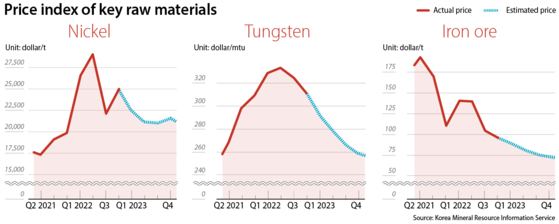Raw material prices to decrease, stabilize amid global economic slowdown

The prices of raw materials are retreating and are projected to stabilize this year as the global economy slows.
The latest update on mineral prices showed a decline in the cost of key commodities as of the first week of January. Prices of copper ($8,345 a ton) and zinc ($3,004 a ton) fell 0.8 percent and one percent each compared to the week before, according to the Korea Mine Rehabilitation and Mineral Resources Corporation. Nickel saw a 3.3 percent price decrease on week.
“Concerns over an economic slowdown caused by China's resurgence of Covid-19 and interest rate hikes in major countries have put pressure on non-ferrous metal prices,” the mining agency said.
According to the Korea Mineral Resource Information Service (Komis), the mineral price index of the 15 most in demand minerals in Korea was 3,437.03 as of Wednesday — high compared to a year ago when it stood at 2,858.53.
However, experts forecast the demand for raw materials will fall as rapid inflation along with rate hikes in major countries disrupt corporate activities.
The International Monetary Fund lowered this year's forecast for global economic growth to 2.7 percent, adding that more than a third of the global economy will contract this year or next.
The prices of nickel and cobalt — needed to make electric vehicle batteries and thus considered key minerals — have declined this year. The price of lithium, which is an essential element for batteries and ceramics used in construction, are falling after soaring to record-high prices last November. It peaked at 581.5 yuan ($85.87) per kilogram and then fell to 452.5 yuan as of Tuesday — partly due to the construction industry decelerating in China.
According to the medium-term price outlook by Komis, the prices of uranium, copper, zinc and tungsten are believed to have peaked last year and are projected to follow a downward curve until 2024. Zinc hit a record high of $3,914.6 per ton in the second quarter of last year, but is expected to fall to $2,689 by the fourth quarter of this year.
“Industrial raw materials prices such as iron ore, tungsten and copper are expected to fall stably and not fluctuate as much as last year,” said Kang Cheon-gu, a visiting energy resources engineering professor at Inha University. “Prices of essential minerals used in batteries, such as lithium, may fall in the first half of the year and rise slightly in the second half due to increased demand for electric vehicles.”
But there are risk factors that could impact the optimistic outlook, such as Covid-19 uncertainties in China and the Russia-Ukraine war. Prices are likely to rebound if China recovers from its Covid-19 outbreak faster than expected.
“If raw material prices rise following China's economic rebound, damage to countries with dependence on raw material imports, like Korea, is inevitable,” Daishin Securities researcher Lee Da-eun said.
The United States, Europe and China are racing to procure key minerals.
The Korean government is also calling for hurried efforts to secure a stable supply chain of raw materials.
“Korea needs to recover secondary raw materials through mineral recycling and actively participate in cooperation on global supply chains,” the Korea International Trade Association noted in a recent report.
BY JEONG JONG-HOON, SEO JI-EUN [seo.jieun1@joongang.co.kr]










with the Korea JoongAng Daily
To write comments, please log in to one of the accounts.
Standards Board Policy (0/250자)